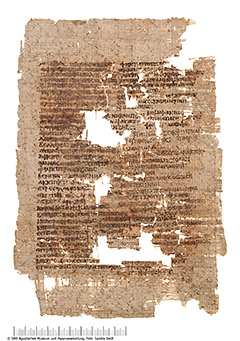P. 10582
Anyone who spends time in language classes and thinks that everything used to be better in the past, because they did not have to speak so many languages, is wrong. In the past it was also very advantageous to speak several languages, especially if you wanted to become politically active. It is, therefore, not surprising that multilingual documents are found.
An interesting example is the trilingual discussion book from the 5th/6th century AD, which was acquired in 1906 in Egypt. It is written on both sides and each page is divided into two columns, each of which is divided into three columns. The columns are divided by colons between the words. In the first column, under Word below Word, there is a Latin text written in Greek letters. In the middle column follows the Greek translation and in the third column the Coptic translation of the respective latin word in the first column. This division extends over the entire papyrus. Thus, one receives the same text in three different languages, each with a literal translation.
The first 41 lines deal with activities and conversations at the end of a meal between the guests and the host. These include wiping the tables, putting up chandeliers, dessert and an invitation to stay overnight. In the second part, lines 42 to 143, under the heading „Everyday conversation“, a short conversation is given at the arrival of a messenger bringing a letter. In this letter, the contents of which are presented, the sender complains that he has not received a letter from the addressee for so long and asks for letters. The end contains a conversation at the front door.
This document is not the only one that translates from one language into another, but nevertheless it is special. In Latin-Greek glossaries the columns were much narrower and each of the two languages had its own column and the Latin words were not transliterated with Greek letters. However, the division on this papyrus is similar to that of the Greek Coptic glossaries, where the words are separated by colons. The form of the content is already known from older examples as „Hermeneumata Pseudodositheana“ and was developed to teach the Greek language to the people in the Roman Empire. This suggests that the text was originally a Latin-Greek text and that the Latin words were originally written with the Latin alphabet.
The reason for the creation of the text is unclear. Since the Coptic text is full of mistakes, while the Greek and Latin are in much better condition, the assumption that a Coptic native speaker wrote the text is not very obvious, but this raises more questions about the layout. It can be assumed that this document is a copy of a copy. At the beginning there was a Latin-Greek text that was copied by a Coptic native speaker, this explains why a Greek-Coptic layout was chosen. This copy was then perhaps copied again – probably by a Greek with only basic knowledge of the Coptic language, as the mistakes show. Furthmore, it would make little sense for someone whose mother-tongue is Latin to transliterate the Latin words with Greek letters. The second copyist, perhaps a pupil or student, but by no chance a professional scribe, was supposed to use this copy to learn the Coptic language.
Although it is unclear who or what stands behind this document and its form, it is of great importance, since multilingual documents have always been a great help to learn languages, to be explored and even in these days to obtain new perspectives.



